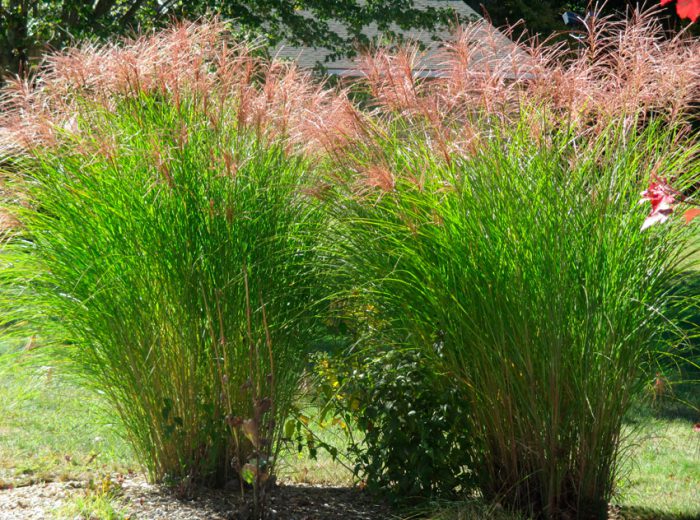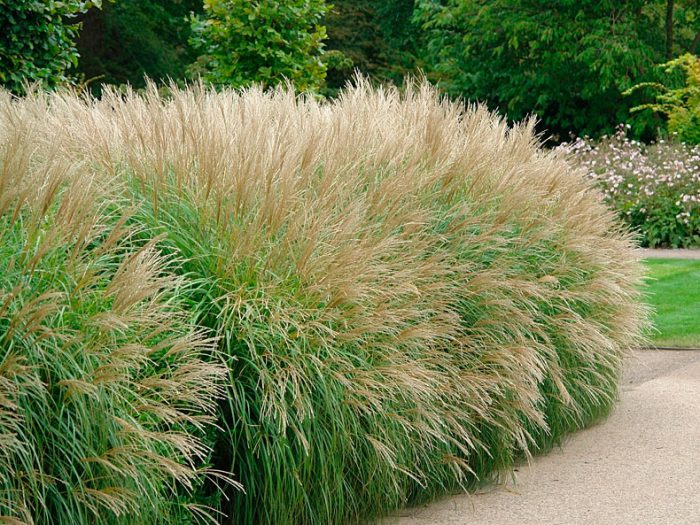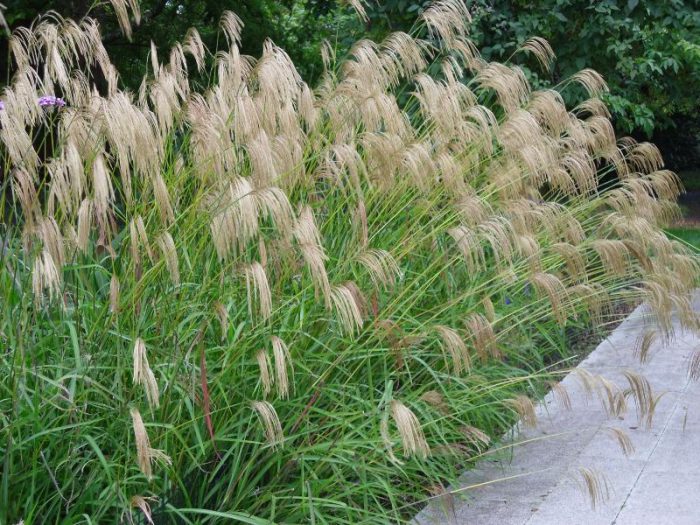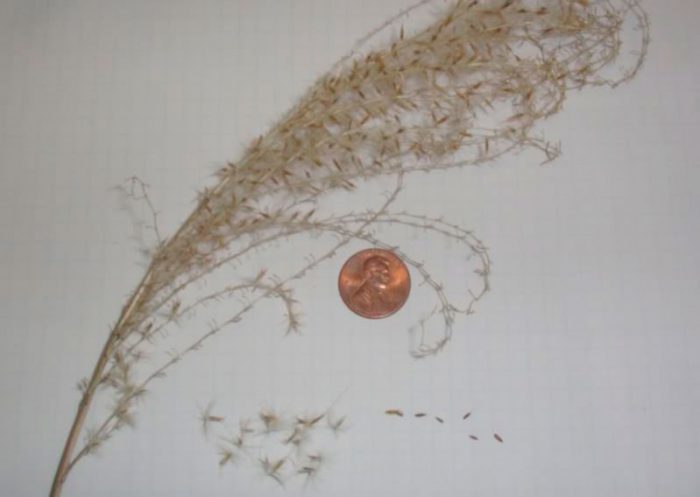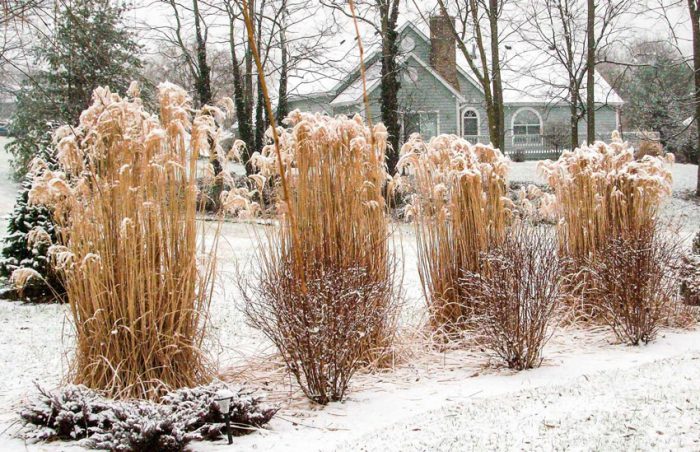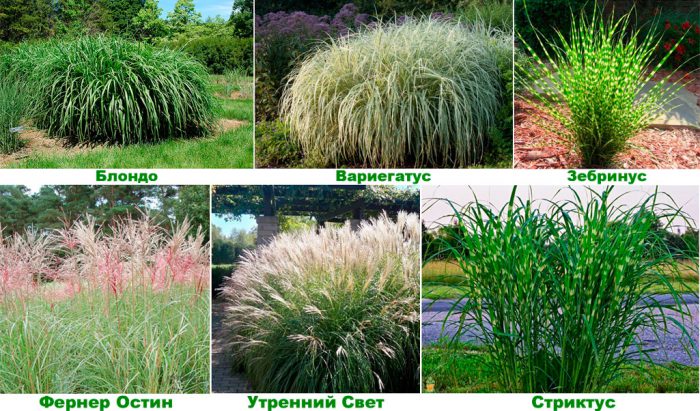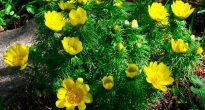Miscanthus, which is also called a fan, is closely related to sugar cane and is directly related to the genus of herbaceous perennial plants of the bluegrass family (cereals). Under natural conditions, such a plant can be found in the tropical and subtropical regions of Australia, Asia and Africa. This genus unites about 40 species. This decorative cereal is very popular among gardeners. In landscape design, lawns and decorative ponds are decorated with miscanthus, and this cereal is also indispensable for creating dry floristic compositions.
Content
Features of miscanthus
Miscanthus is a perennial plant and can grow in height from 0.8 to 2 meters. In some cases, its creeping rhizomes reach six meters depth. The stems are erect. The width of the leathery, scaly leaf plates is from 0.5 to 1.8 centimeters. Spikelets are part of the fan-shaped panicles 10-30 centimeters long. Such a plant is distinguished by its unpretentiousness, endurance and environmental safety. This decorative grain is still used as a fuel for power plants, since when it is burned, a large amount of energy is released, and very little ash is formed, because the raw material contains a small amount of moisture.
Planting miscanthus outdoors
What time to plant
It is necessary to plant miscanthus in the spring after the soil warms up well (from the last days of March to the second half of May). This cereal is thermophilic; therefore, for planting it, it is necessary to choose sunny, well-heated areas that are protected from the cold wind. These plants need sufficient water and are best suited to moist nutrient soil located in the coastal area. Miscanthus does not have any special requirements for the soil, but it grows and develops very poorly on heavy clay and sand.
How to plant
For planting, you will need to purchase adult seedlings from a specialized store. The fact is that this cereal has a rather long period of active growth. It should be borne in mind that such a plant starts growing only after the air warms up to 25 degrees.In this regard, if you plant a young seedling, then it simply does not have enough time to settle down well before the onset of frost and prepare for wintering. An adult seedling is able to tolerate even a frosty winter period normally, if it is provided with good shelter. The volume of the hole for planting should not be much larger than the size of the root system of the seedling. First, a layer of nutrient soil is poured into the hole, and then a seedling is placed in it. The pit is covered with soil, while constantly compacting it so that no voids remain. The planted plant must be watered very well.
Caring for miscanthus in the garden
Miscanthus needs timely watering, otherwise it can dry out quickly. Particular attention should be paid to watering this cereal during a dry and sultry period. Hose watering is recommended for such a plant, while it should be as abundant as possible. In order for the ornamental cereal to grow and develop normally, it needs systematic feeding, which must be moderate, for example, an excessive amount of nitrogen can cause miscanthus to lodge. The planted cereals do not feed the first year. Then, in mid-May, liquid fertilizing with nitrogen-containing fertilizers is used (for example, a urea solution). In the first half of the summer period, plants will need watering with humates, and in the second, phosphorus-potassium fertilizer is applied to the soil. Also, the plant will need systematic weeding for at least two years in a row, then it will get stronger and grow strongly, so the weed on the site will stop growing on its own. It is not required to loosen the soil surface in the area with miscanthus.
It should also be noted that this cereal is a very aggressive plant that is capable of growing and surviving other flowers. Therefore, even during planting, special restrictions must be made; for this, limiters are used, in the role of which pieces of slate or sheets of iron can act. They should be dug in along the entire perimeter of the site, and there should not be even minimal gaps and gaps. The limiters should be dug in at least 0.2 m deep, and they should also rise above the ground surface by about 10 centimeters, which will not allow the plant roots to "jump" the border.
There are species in which by the end of the summer period the leaf plates located below are lost, from which the decorative effect of this cereal decreases somewhat. In order for the lower “bald” part of the miscanthus to be less conspicuous, it is recommended to plant a high hostu in the immediate vicinity (from 0.5 to 0.6 meters), which grows very well in highly moistened soil.
Almost any gardener can handle the planting of miscanthus, as well as its cultivation, and this cereal will certainly become the main decoration of any garden.
Reproduction of miscanthus
Such a plant reacts quite negatively to transplants, but after some time in the central part of the bush, the old stems begin to die off, and therefore the gardener thinks about replanting the miscanthus. As a rule, together with the transplant, the plant is propagated by dividing the bush. The division is recommended to be done in spring or summer. It should be borne in mind that this procedure must be done very carefully, because the restoration of this cereal after division takes a very long and painful time.
Miscanthus can also be grown from seeds. Seeds do not need to be prepared before sowing, but if you choose this method of propagation, then you should take into account that you will have to be patient. The fact is that such a cereal grown from seed reaches the peak of its decorative effect only 3 or 4 years after sowing. It is recommended to sow seeds in individual peat pots, and after the soil warms up well in spring, the seedlings of miscanthus can be transplanted into open soil.However, it should be borne in mind that plants grown from seeds are not able to maintain varietal characteristics.
Pests and diseases
Such a plant has incredibly high resistance to a wide variety of diseases and harmful insects.
Miscanthus after flowering
There are types of miscanthus that are frost-resistant, while others just need a good shelter for the winter. If you have planted a rather delicate variety of such an ornamental cereal, then you will have to provide it with protection from both frost and sudden changes in temperature. In the event that it gradually gets colder outside, the cereal can have time to adapt, but if the frost is unexpected, then the bushes in most cases die. In order to protect such ornamental plants, it is necessary to cover the bushes with a film, placing it in a hut, while air must be supplied from the side parts under the shelter. Then, on top of the film, you need to install 2 wood shields in the same hut. However, before covering the miscanthus, it is necessary to cover the area where it grows with a very thick layer of mulch, which can be used as any loose soil.
Types and varieties of miscanthus with photos and names
Miscanthus giant (Miscanthus giganteus)
This species has long been cultivated by gardeners, and experts believe that it is a complex hybrid, but no one knows how it originated. Erect shoots can reach a height of 300 centimeters. Weeping leaf plates are about 0.25 m wide. They are colored dark green, with a white stripe running along the central vein. From the escape, the leaves diverge in different directions, which outwardly is very similar to a large fountain. Flowering is observed at the end of the summer period, with light pink panicles appearing, acquiring a silvery color over time. If the summer period in the region is cold, then miscanthus may not bloom at all. Often this species is planted as an accent in the background. It should be noted that at the end of the summer period, the lower leaves of it fade, in this regard, the lower part of the miscanthus will need to be masked.
Chinese Miscanthus (Miscanthus sinensis)
Under natural conditions, this species can be found in Korea, Russia, China, and also Japan. This perennial is a grass with a loose bush. He has a fairly short rhizome, and erect shoots in height can reach about 300 centimeters. Rough rough linear leaf plates are about 15 millimeters wide, with a rough rib running along the central vein. During flowering, single-flowered spikelets appear, which can reach 0.7 centimeters in length, while they are part of loose panicles. It has been cultivated since 1875. It does not differ in high frost resistance, in this regard, it simply needs a dry shelter, while by winter one should not forget to sprinkle the area with a thick layer of mulch. This type is most popular with gardeners and there are about 100 of its varieties, which differ in the shape and color of the inflorescences, as well as in the shape and size of the bush itself. These include both frost-resistant varieties and those that prefer to grow in warm climates.
Varieties:
- Blondeau... It can reach a height of 200 centimeters. It is frost-resistant enough; no shelter is required for the winter.
- Variegatus... In height, a dense bush can reach only 150 centimeters. On its leaf plates there are longitudinal stripes of white color.
- Miscanthus Zebrinus (sometimes referred to as Zebrin miscanthus). The variegated bush on green leaf plates has yellow stripes that are located transversely.
- Ferner Austin... The bush can reach a height of 150 centimeters. On narrow green leaf plates along the central vein, there is a white stripe, which turns reddish-red in autumn.In August, fan-shaped panicles of deep red color with white tops bloom, over time they change their color to bronze-silver.
- Morning light... A beautiful not very tall bush has narrow leaf plates with a white edging. Flowering occurs quite late and not annually.
- Strictus... The bush reaches a height of 2.7 meters, the width of its rich color of variegated leaf plates is about 15 mm. On the leaves, green and rich white stripes are alternately located, loose panicles consist of single-flowered pale red spikelets.
Sugar-flowered Miscanthus, or Sugar-flowered (Miscanthus sacchariflonis)
Under natural conditions, it can be found in Russia in humid areas from the south of Primorsky Territory to the Amur Region, as well as in China, Korea and Japan. In height, a bush with bare shoots can reach 200 centimeters. The drooping linear leaf plates are painted in a pale green color, they are one and a half centimeter wide, and about 0.6 m long. Panicles reach 0.25 m in length, and they are painted in white or pink-silver color. This species belongs to the thermophilic species, therefore, its growing season begins at the end of the spring period, however, its growth is high throughout the warm season. Flowering begins in July, and such a cereal can maintain its decorative appearance until October. It is frost-resistant enough, no shelter is required for wintering, however, it is better to mulch the site in case of a snowy winter period. The most popular form is Robustus; it has a slightly larger bush than that of the main plant.


Watch this video on YouTube

